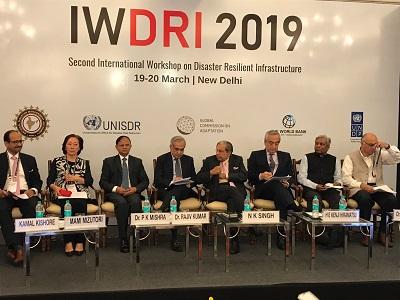
The panel of speakers at the opening today of the 2nd International Workshop on Resilient Infrastructure in New Delhi
By Denis McClean
NEW DELHI, 19 March, 2019 - Ambition on building resilient infrastructure needs to match the scale of the problem. That was the message to participants attending the opening today of the 2nd International Workshop on Disaster Resilient Infrastructure.
“Yesterday was the 4th birthday of the Sendai Framework. It is no longer a 15-year framework but an 11-year framework. This is the time to come up with bold initiatives. The time to think at the edges is gone, now is the time to do bold things,” said Kamal Kishore, of India’s National Disaster Management Agency which is leading an initiative to “co-create” a global Coalition for Disaster Resilient Infrastructure.
Three major examples of resilience building in India were cited by Dr. Junaid Kamal Ahmad, Country Director, World Bank Group: the world’s largest rural roads programme, the world’s largest dam improvement projects, and the efforts of the India State of Kerala not simply to rehabilitate the areas devastated by floods last year but to build back better.
He said India is an example of a country that is embedding resilience into how it approaches major infrastructure projects and there is a challenge to capture that knowledge and spread it further.
Dr. Ahmad made three recommendations for the future management of resilient infrastructure: to focus on creating centers of excellence, strengthening institutions to ensure accountability and encourage stronger relationships between local government and citizens to deal with shocks across the world.
Ms. Mami Mizutori, the UN Secretary-General’s Special Representative for Disaster Risk Reduction, welcomed the Indian government’s initiative to develop a Coalition for Resilient Infrastructure.
She said: “We are challenging ourselves on how we can disaster proof a world that lives under serious existential threat. We are advocating for change, and the change we seek is to live in a world where building to last becomes the norm, rather than trying to build back better after a disaster strikes.”